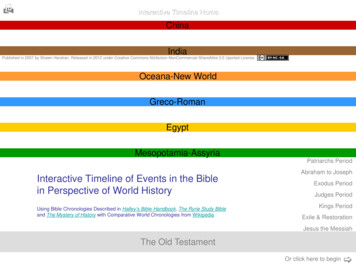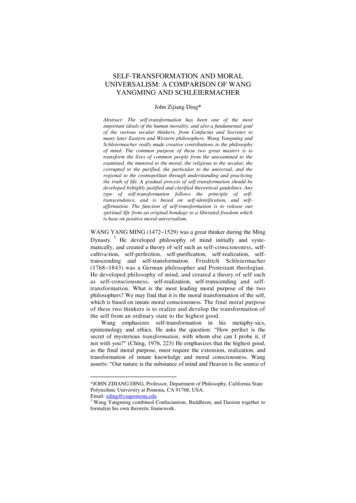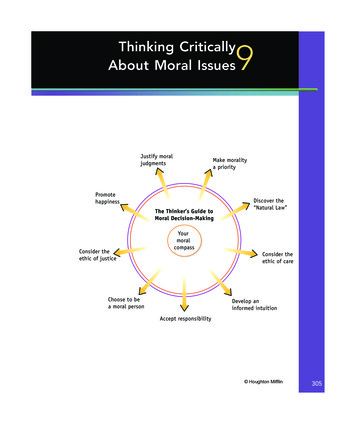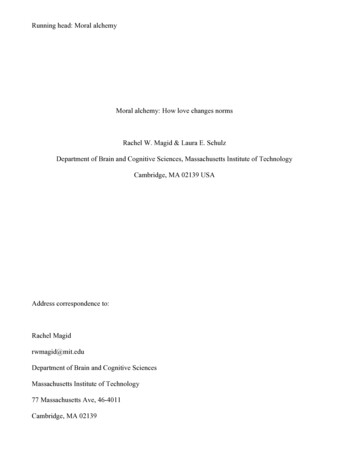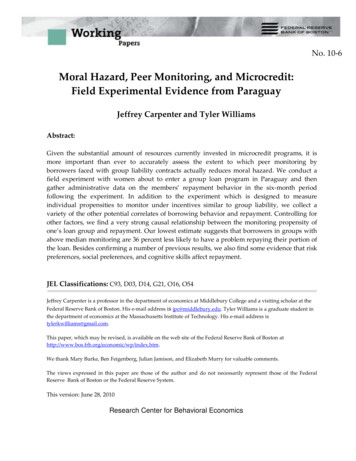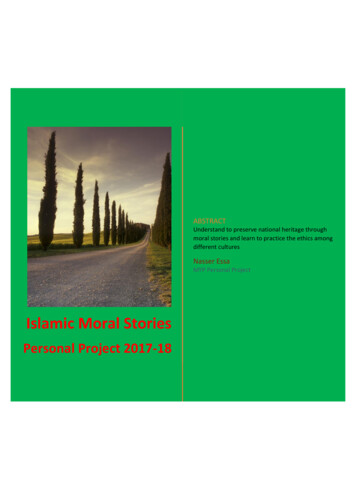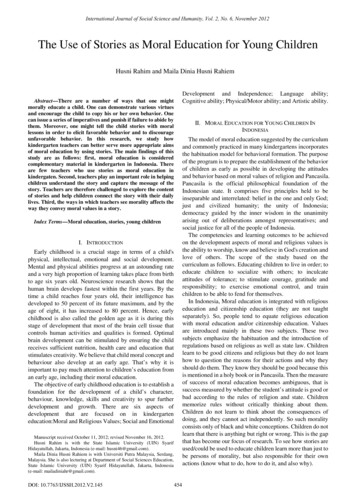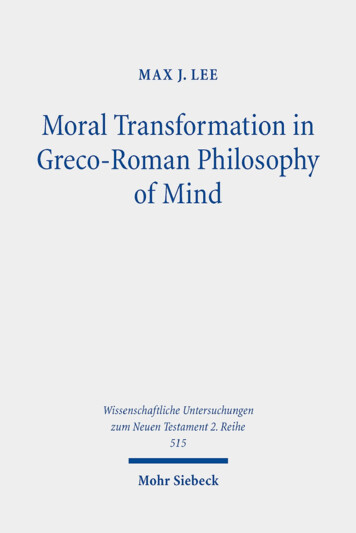
Transcription
To our parentsJohn and Esther Leeand Nam Soon Kwonfor their love, prayers, and unfailing supportInstitue adulescentem iuxta viam suam,etiam cum senuerit, non recedet ab ea.Proverbs 22:6
PrefaceThis project has undergone several changes since its first inception as adoctoral dissertation accepted by Fuller Theological Seminary in 2002under the title “Greco-Roman Philosophy of Mind and Paul.” When thedissertation was first accepted into the WUNT II series, Professor JörgFrey, then and current editor, suggested saving the material on Paul foranother book and expanding the remainder on Greco-Roman philosophy ofmind in two ways by: 1) adding a section on the role of the divine in moralprogress for each philosophy, and 2) enlarging the analysis on DiasporaJudaism into separate chapters. Little did I know that these revisions wouldevolve into an almost two-decades long project where sections expandedinto chapters, and major parts of the book expanded into separate works.This present book, Moral Transformation in Greco-Roman Philosophy ofMind, is a stand-alone and foundational work which maps out the moralmilieu of the Apostle Paul and his Diaspora Jewish contemporaries bydescribing the ethical systems of, and reconstructing models of moraltransformation for, Platonism and Stoicism. It ends with a Retrospect andProspect that compares the two systems as theoretical poles and outlines thespectrum they create along which other systems can be assessed. A separatecompanion work under a new title will be published later that reconstructsthe moral transformation systems of Epicureanism and Diaspora Judaism.This second book will end with a scheme for mapping a common ancientethical tradition across Platonism, Stoicism, and Epicureanism to whichJudaism and Pauline Christianity also make conceptual contributions.These two books are the beginning segment of a career-long researchagenda where I seek to publish additional works on how the Apostle Paulappropriates the language of philosophical discourse in his moralexhortations to his Gentile churches. These books also set the stage forexploring how Paul engages with competing philosophical systems thatinformed the ethics and behavior of his letter recipients. It is my hope thatthis present book on Platonism and Stoicism (along with the ensuing bookon Epicureanism and Diaspora Judaism) can provide encyclopedicknowledge for the New Testament scholar unfamiliar with Greco-Romanphilosophies of mind and propose ways for the expert to systematize theircontent into coherent models of moral transformation.
VIIIPrefaceI am grateful not only for the patience and support of Professor Frey overthese many years to see the project to completion but also his willingness topublish a contracted single book into two separate individual works. Thanksalso to the past and current staff of Mohr Siebeck for their excellenteditorial help, especially Dr. Henning Ziebritzki and Ms. Elena Müller.I stand indebted to many (Rom 13:8) who have helped me directly in thewriting of this book and indirectly by contributing to my life’s journey. Iowe a tremendous debt of gratitude to my dissertation supervisor ProfessorJudith Gundry who, despite her move from Fuller to Yale Divinity Schoolin 1998, kept me as her student and since then has been an invaluablesource of counsel and support throughout my vocation as a theologicaleducator. Words cannot express my thankfulness for Professor Seyoon Kimwho has been a second Doktorvater to me and whose mentorship hasformed my identity as a scholar, teacher, and minister of the church. In Dr.Kim and Dr. Gundry I could not find better mentors. Their sage advice andfriendship has been, and continues to be, a gracious gift.Over the years at various conferences and universities where I conductedand presented my research, I have enjoyed both discussion and debate withleading scholars in the field of classical studies and early Christianity. Iwish to thank Professor Troels Engberg-Pedersen, Professor David Sedley,Professor James Warren, and the late Professor Abraham Malherbe for theirinterest in my work on Stoicism and Epicureanism.Part of my research was supported by the Lilly Theological ScholarsGrant administered by the Association of Theological Schools. The grantfunded my post-doctoral study at Durham University, England, in October–November 2010. I wish to thank my sponsor Professor John Barclay, aswell as Professor Francis Watson and Professor Walter Moberly, for theirwarm welcome and for inviting me to give a paper on “Ancient EthicalTheory and Paul” at the New Testament Research Seminar. ProfessorGeorge Boys-Stones also attended the seminar and during my stay atDurham provided direction in my work on Middle Platonism.In my career, I have been blessed to teach at fantastic institutions ofhigher learning. Many thanks to the deans, faculty, and staff at WestmontCollege (2002–2003), Wheaton College (2003–2006), and North ParkTheological Seminary (2006–present). Special thanks to Professor KlyneSnodgrass, Professor Robert Hubbard, Professor James Bruckner, andProfessor Stephen Chester, all of whom during my time at North Parksupported my scholarship and whose friendship I treasure to this day. Atthese institutions, several research assistants helped me with the book andwhile I cannot name them all, I thank them, and especially Ms. MeganHerrold who took on the lion’s share of the work to proof-read various
PrefaceIXdrafts of the manuscript and compile the indices. I am grateful for thesabbatical leave supported by North Park, the leadership of my currentdeans Dr. David Kersten and Professor Dwight Perry, and for the help ofthe staff at Brandel Library, especially Dr. Stephen Spencer.My wife, Sukyung Lee, has carried the largest burden, spiritually,emotionally, and financially. Her prayers, love, and fortitude have seen usthrough some very tough years, and I could not have made it this farwithout her. My love and appreciation for her only grows each day. Thanksalso to my sons Zachary and Jonathan who grew up with “the book,” arenow in college, and whose presence in my life is a constant reminder ofGod’s grace. My younger brother Eugene Lee, his wife Sarah, and theirdaughters Ava and Alex have also waited eagerly with us for the day of thebook’s completion. So have Su’s aunts Ms. Ok Soon Kwon and Ms. KwangJa Kwon. Thank you for standing by us.Both Su and I want to express our indebtedness to our pastors andChristian brothers and sisters from whom we received much love andprayers. While we wish we could name every person whom God has used toencourage us in our life’s journey, we instead thank our spiritual families bychurch name and name individually only a few. Thank you BerklandBaptist Church, Life Baptist Church, and Park Community Church for allthat we received from you and the formative influence you have had inshaping our and our children’s walk with Christ. We especially thank PastorPaul and Rebekah Kim, Pastor Andy and Grace Pak, Pastor Daniel and SueIm, Pastor Peter and Eunice Lee, Pastor James and Soomi Suh, PastorStephen and Ellen Jung, Pastor Daniel and Mona Lee, Pastor Ed and KellyKang, Pastor Chris and Sally Pak, Pastor Brian and Brittany Park, PastorSteve and Rachael Kim, Mr. John and Professor Loan Kim, Mr. Bert andMrs. Anne Han, Pastor Scott and Linda Clifton, Pastor Joel and AlizaSettecase, Pastor Dan and Courtney Osborn, and Dr. Valerie Landfair.This work is dedicated to my parents: Mr. John J. Lee and Mrs. EstherLee, and to Su’s mother, Mrs. Nam Soon Kwon. From cradle to today, theyhave never stopped praying, encouraging, supporting, and loving us. Theyhave believed in my work and walked with us through every valleymoment. Mom, Dad, and Omonim, we rejoice that we can also share thismountaintop experience with you. You have taught us that in all things,good and bad, to give thanks to the Lord and live according to his purpose(Rom. 8:28). We love you.Ad Dei gloriam et laudemChicago, Illinois, Advent 2019Max J. Lee
Table of ContentsPreface . VIITable of Contents . XIAbbreviations and Primary Sources Table XVIIPart I: Mapping the Apostle Paul’s Moral Milieu1Chapter 1: An Introduction to Greco-Roman Philosophy of Mind . 31. What Is Ancient Philosophy of Mind? . 32. Which Moral Transformation Systems and Why . . 53. Power, Human Agency, and Divine Correspondence . . . 12Chapter 2: Contingency, Coherence, and Philosophical Systems . 171. Methods and Models . 171.1. A Proviso on the Use of the Term System . . 171.2. Toward an Abstracted Model of Moral Transformation . . 232. Components to Moral Transformation 312.1. Why Begin with the Passions: Defining Their Structure and Power 312.2. Philosophical Reactions to Popular Views on the Passions 332.3. Self-Mastery, Moral Action, Virtue, and Other Components 37Fig. 1: Self-Mastery, Temperance, and Character Formation 40Summary Remarks for Part I 45Part II: Moral Transformation in Middle Platonism47Chapter 3: The Body-Beating Platonist: The Non-Cognitive Structure ofthe Passions and the Platonic Counter-Cycle of Virtue Against Vice . 491. Introducing Middle Platonism . 491.1. The Founder and His Followers: Plato, Plutarch, Alcinous, and Galen . 501.2. Unifying Doctrines and Common Commitments . 51
XIITable of Contents2. Self-Mastery as Moderation of the Passions 562.1. The Platonic Non-Cognitive Theory of Emotions 572.2. The Platonic View of Self-Mastery 663. Vice, Virtue, and Character Formation . 733.1. The Cycle of Error and Vice 753.2. The Counter-Cycle of Virtuous Action, Habit, and Character Formation 78Fig. 2: The Middle Platonic Program of Behavior Modification 853.3. Debilitating Desire and Exercising Reason’s Power 88Fig. 3: Plato’s Anthropology 98Fig. 4: Middle Platonic Anthropology 99Chapter 4: “Becoming like God” and Nurturing Moral Progress inMiddle Platonism . 1031. The Goal to “Become like God” . 1031.1. Plato’s Tension between the Virtuous Life and a Life of Contemplation . 1031.2. Assimilation through Contemplation 1051.3. Assimilation through the Moral Life 1122. Diverse Ways of Imitating the Divine: How the Middle Platonists ResolvedPlato’s Tension 1192.1. Moral Likeness to a Lesser, Demiurgic God according to Alcinous 123Excursus: Plato’s Theology 129Table 1: Plato’s Metaphysical Framework 130Table 2: Plato’s Religious / Mythic Framework 131Table 3: Alcinous’ Theology . 1342.2. Moral Likeness to the Thoughts of the First God according to Alcinous 1362.3. Moral Likeness to the Divine Attributes of God according to Plutarch . 139Table 4: Plutarch’s Theology 1472.4. A Non-Platonist Account of Assimilation to God according to Galen 1483. Nature versus Nurture: Mentors, Friends, and the Hard-Wired Limitations toMoral Progress 1553.1. “To Know Thyself” Requires the Help of Others . 1563.2. Moral Mentors and Frank Friends . 1583.3. Nature’s Limits on Moral Progress 162Summary Remarks for Part II . 171
Table of ContentsPart III: Moral Transformation in StoicismXIII173Chapter 5: The Superhuman Stoic: The Cognitive Structure of thePassions and the Perfection of Moral Judgment 1751. Introducing the Roman Stoa of the Early Imperial Period 1751.1. The Founders and Their Followers: The Old Stoa, Seneca, Musonius Rufus,Epictetus, and Other Greco-Roman Stoics 1771.2. Neostoic Orthodoxy and Innovations . 1792. The Stoic Cognitive Theory of Emotions . 1832.1. The Taxonomy of Emotions 1842.2. The Mind Experiences an Appearance (Stage 1) 1882.3. The Mind Judges the Impression (Stage 2) 1902.4. The Judgment Produces an Impulse (Stage 3) 1932.5. The Impulse Moves the Human Agent toward Action (Stage 4) 1952.6. A Stoic Example from Euripides on the Cognitive Origin of Emotion 2023. The Stoic View of Self-Mastery . 2073.1. Aiming for Stoic ’Apa,qeia 2073.2. Extirpating the Passions 2133.3. Self-Mastery and Temperance as the Consistent Exercise of Knowledge 219Chapter 6: The Good, the Bad, and the Indifferent: Stoic MoralPsychology of Action and Character Formation . 2211. The Cognitive Formation of Virtue versus Vice 2211.1. Virtues as Types of Knowledge and Virtue as a Stable State 2221.2. Vices as Types of Ignorance and Viciousness as an Unstable State 2262. The Instantaneous and Comprehensive Character of Stoic Perfection 2282.1. The Taxonomies and Unity of the Virtues 2282.2. Transformation as Radical Change not Gradual Progress . 2362.3. Stoic Perfection: Available to All, Attainable by Few . 2423. Moral Valuation, Action, and Choice 2453.1. Defining the Good, the Bad, and the Indifferent 2473.2. Distinguishing Preferred versus Dispreferred Indifferents 253Fig. 5: Goods, Evils, and Indifferents (Preferred, Dispreferred, or Neither) 2583.3. Types of Moral Acts: Right, Erroneous, Appropriate, and Unsuitable 259Fig. 6: Appropriate vs. Inappropriate Acts: Right, Intermediate,and Erroneous 2613.4. A Very Short Epitome of Stoic Ethics 270
XIVTable of ContentsChapter 7: Neostoic Innovations to Chrysippan Moral Psychology 2711. The Prominence of Power Language in Neostoic Accounts 2711.1. The Exaggerated Power of Appearances, Assent, and Impulses 2721.2. The Excessive Power of the Passions and Epictetus’ Deconstruction ofMedea as a Denial of ’Akrasi,a 2811.3. Rational Power according to Musonius Rufus and Marcus Aurelius . 2922. Componential Theories on the Formation of the Passions 2962.1. Panaetius on Impulsive Power versus Rational Power 2982.2. Posidonius on Cognitive Passions Charged by Bodily Impulses 3022.3. Seneca on the Pre-Passions 3073. Componential Theories on Non-Cognitive Aids to Self-Mastery 3153.1. Diogenes of Babylon on Music’s Contribution to Self-Mastery 3173.2. Posidonius on Moderating Affective Movements with Music 3253.3. Seneca on Pacifying the Pre-Passions with Poetry 328Chapter 8: Neostoic Innovations in Habit, Practice, and Mentoring 3321. Non-Intellectual Virtues and Vicious Habitudes 3321.1. Defining Non-Intellectual Virtues as Skills or Habitudes 3331.2. Proclivities, Sick Habits, and Infirmed Conditions 3392. Spiritual Exercises and Practicing Philosophy 3452.1. Practicing Philosophy and Why Knowing Is Not Enough 3462.2. Types of Spiritual Exercises 3563. Mentoring Students to Practice Philosophy 3633.1. Seneca on Mentorship in Stoicism and Other Philosophical Traditions 3643.2. From Mentors and Students to a Society of Stoic Friends 370Chapter 9: The Stoic Self 3751. Oivkei,wsij and the Formation of the Integrated Self 3751.1. Hierocles on Oivkei,wsij, Self-Preservation, and the Constitution of Self 3781.2. The Doxographers on Appropriation and Appropriate Acts 3811.3. Stoic Ethics as the Rational Outworking of Pre-Rational Oivkei,wsij 3851.4. The Integrated Self: From Individual to Social Oivkei,wsij 3962. Stoic Anthropology as Material and Monistic 4012.1. The Human Person as an Ensouled Body and Embodied Soul 4012.2. The Monism of the Soul and Rational Agency 4072.3. An Epitome of Stoic Humanity . 410
Table of ContentsXVChapter 10: The Stoic God and Imitatio Dei 4111. The Nature of God and Humanity’s Role in the Cosmos 4111.1. A Matrix of Interentailing Propositions on the Nature of God 4111.2. God’s Providence, Natural Determinism, and Moral Responsibility 4181.3. Epictetus on Proai,resij and Neostoic Developments on Freedom 4292. The Imitation of God as the Stoic Te,loj 4372.1. Living according to Nature, Reason, and Virtue 4382.2. Imitating the Rational and Virtuous God 4412.3. The Role of God in Stoic Moral Progress 452Summary Remarks for Part III 455Part IV: Retrospect and Prospect459Chapter 11: Retrospect: Models and Milieu 4611. The Middle Platonist Model of Moral Transformation 4611.1. Platonist Moral Psychology 4621.2. The Platonist Cycle of Vice and Counter-Cycle of Virtue 4631.3. Social Structures Reinforcing the Attainment of Virtue 4641.4. Integrating Assimilation to God with Moral Formation 4641.5. A Platonist Model of Reinforcing Concentric Cycles . 468Fig. 7: The Middle Platonist Model of Moral Transformation . 4692. The Stoic Model of Moral Transformation 4702.1. Stoic Moral Psychology 4702.2. Stoic Moral Valuation of the Good, the Bad, and the Indifferent 4722.3. Instantaneous Transformation and the Analogue of a Titration Point 472Fig. 8: The Early Stoic Model of Moral Psychology, Action, and Perfection 4742.4. Neostoic Innovations to the Chrysippan Model of Perfection 475Fig. 9: Neostoic Innovations to Early Stoic Moral Psychology and Formation 4752.5. An Integrated Stoic Model: Transformation, Imitatio Dei, and Oivkei,wsij. 479Fig. 10: The Stoic Model of Moral Transformation 4813. Mapping the Moral Milieu of the Apostle Paul between Platonism and Stoicism 4833.1. The Importance of Platonism and Stoicism in the Transitional Period 4843.2. Comparisons between the Models and the Spectrum They Create 487Fig. 11: Greco-Roman Philosophies in a Non-Cognitive toCognitive Spectrum 489
XVITable of ContentsChapter 12: Prospect: Interactions, Intertextuality, and Encyclopedia 4931. Intertextuality, Greco-Roman Allusions, and the Types of Interactions betweenPhilosophical Schools 4931.1. Eclecticism (Type of Interaction 1) 4941.2. Refutation (Type of Interaction 2) 4971.3. Competitive Appropriation (Type of Interaction 3) 4981.4. Irenic Appropriation (Type of Interaction 4) 5031.5. Concession (Type of Interaction 5) 5061.6. Common Ethical Usage (Type of Interaction 6) 5121.7. Implications for Detecting Greco-Roman Allusions in the New Testament 5162. Where Do We Go from Here? . 5192.1. An Estimation of Epicureanism and Diaspora Judaism in the Spectrum . 519Fig. 12: Epicureanism and Judaism between Platonism and Stoicism . 5222.2. Toward a Common Ancient Ethical Tradition 523Closing Remarks . 527Appendix 1: The Philosopher Plato and the Legacy of the Academy:Sources for Middle Platonism 5311. The Life and Works of Plato 5312. The Life and Works of Plato’s Greco-Roman Heirs: Plutarch, Alcinous,and Galen 535Appendix 2: Zeno, Chrysippus, and Their Late Hellenistic and Imperial Heirs:Sources for Early, Middle, and Roman Stoicism 5451. Zeno, Chrysippus, and the Early Stoa 5452. Sources for Middle Stoicism 5533. Sources for Roman Stoicism 555Bibliography 567Index of Ancient Sources 609Index of Modern Authors 635Index of Subjects 643
Abbreviations and Text Editionsfor Greek and Latin Primary SourcesPrimary sources are listed here by the ancient author’s name and generally follow thestyle, conventions, and abbreviations used in The SBL Handbook of Style for BiblicalStudies and Related Disciplines (2nd ed.; ed. by Billie Jean Collins, Bob Buller, and JohnF. Kutsko; Atlanta: SBL, 2014), and The Oxford Classical Dictionary (4th ed.; ed. bySimon Hornblower, Antony Spawforth and Esther Eidinow; Oxford: Oxford UniversityPress, 2012). At times alternative abbreviations are used for lesser known works. Textstaken from the Loeb Classical Library series are noted as LCL. A list of primary sourcesby the editor’s or translator’s last name is provided in the bibliography. Abbreviations forsecondary literature are also taken from The SBL Handbook of Style, and the reader isasked to refer there for the abbreviations of modern sources and series used in this book.Achilles TatiusLeuc. illes TatiusLeucippe et Clitophon. Achilles Tatius, Leucippe et Clitophon(LCL; ed. and trans. by Stephen Gaselee; Cambridge, MA: Harvard University Press / London: William Heinemann, 1917; 2nded., 1969; repr. 1984).AëtiusPlacita. Hermann Diels, ed., Doxographi Graeci (Berlin: DeGruyter, 1879; repr. 1958). Corrected text for Book 2 and Eng.trans. by Jaaps Mansfeld and David T. Runia, Aëtiana: The Methodand Intellectual Context of a Doxographer (vol. 2: The Compendium, Pt. 2; Philosophia Antiqua 114; Leiden: Brill, 2009), 663–715.Albinus’Albi,nou pro,logoj ( Eivsagwgh. eivj tou/ Pla,twnoj bi,blon Introductio in Platonem). Karl Friedrich Hermann, ed., PlatonisDialogi secundum Thrasylli tetralogias dispositi (vol. 6; Leipzig:Teubner, 1880), 147–51; and more recently, Burkhard Reis, ed. andtrans., Der Platoniker Albinos und sein sogenannter Prologos:Prologomena, Überlieferungsgeschichte, kritische Edition undÜbersetzung (Serta Graeca 7; Wiesbaden: Ludwig Reichert, 1999),310–19.AlcinousDidaskalikos. John Whittaker, ed., Alcinoos: Enseignement desdoctrines de Platon (Introduction, texte établi et commenté parJohn Whittaker; traduit par by Pierre Louis; Paris: Les Belles Lettres, 1990). Eng. trans. by John Dillon, Alcinous: The Handbook onPlatonism: Introduction, Translation, and Commentary (ClarendonLater Ancient Philosophers; Oxford/New York: Oxford UniversityPress, 2003). Citations from Alcinous, Didask. are given by chapter no.: paragraph no. following Dillon (with page nos. and line
XVIIIAlexanderDe AnimaFat.MantissaAndronicusApuleiusDe PlatoneAristotleEEENGen. an.Phys.Pol.Metaph.Abbreviations and Text Editionsnos. from the Greek text of the Whittaker edition in parentheticalnotes as necessary).Alexander of AphrodisiasDe Anima ( On the Soul). Ivo Bruns, ed. Supplementum Aristotelicum (vol. 2/1: Alexandri de Anima cum Mantissa; Berlin: G.Reimer, 1897), 1–100. Eng. trans. by Victor Caston, Alexander ofAphrodisias: On the Soul, Part 1: Soul as Form of the Body, Partsof the Soul, Nourishment and Perception (Ancient Commentatorson Aristotle; London/New York: Bloomsbury Academic, 2012).De fato ( On Fate). Robert W. Sharples, ed. and trans., Alexanderof Aphrodisias on Fate: Text, Translation, and Commentary (London: Duckworth, 1983).Mantissa ( Supplement to On the Soul). Robert W. Sharples, ed.,Alexander Aphrodisiensis, De anima libri mantissa: A New Editionof the Greek Text with Introduction and Commentary (Berlin/NewYork: De Gruyter, 2008), 37–142. Eng. trans. by Robert W.Sharples, Alexander of Aphrodisias: Supplement to On the Soul(Ancient Commentators on Aristotle; London/New York: Bloomsbury Academic, 2014).Andronicus of Rhodes. See Ps.-Andr. below.ApuleiusDe Platone et eius Dogmate. Jean Beaujeu, ed. and trans., Apulée:Opuscules Philosophiques et Fragments: Texte établi, traduit etcommenté (Paris: Les Belles Lettres, 1973).AristotleEthica Eudemia. Aristotle, Athenian Constitution, Eudemian Ethics, Virtues and Vices (LCL; ed. and trans. by Harris Rackham;Cambridge, MA: Harvard University Press / London: WilliamHeinemann, 1935).Ethica Nicomachea. Aristotle, The Nicomachean Ethics (LCL; ed.and trans. by Harris Rackham; Cambridge, MA: Harvard University Press / London: William Heinemann, 1926; 2nd ed., 1934; repr.1956).De generatione animalium ( On the Generation of Animals).Aristotle, Generation of Animals (LCL; ed. and trans. by Arthur L.Peck; Cambridge, MA: Harvard University Press / London: William Heinemann, 1942).Physics. Aristotle, The Physics (LCL; 2 vols.; ed. and trans. byPhilip H. Wicksteed and Francis M. Cornford; Cambridge, MA:Harvard University Press / London: William Heinemann, 1929–34;repr. 1980).Politics. Aristotle, Politics (LCL; ed. and trans. by Harris Rackham; Cambridge, MA: Harvard University Press / London: William Heinemann, 1932; 2nd ed., 1944).Metaphysics. Aristotle, The Metaphysics I–IX (LCL; ed. and trans.by Hugh Tredennick; Cambridge, MA/London: Harvard UniversityPress, 1933; repr. 1989); idem, The Metaphysics X–XIV, Oeconomica, Magna Moralia (LCL; ed. and trans. by Hugh Tredennick andG. Cyril Armstrong; Cambridge, MA/London: Harvard UniversityPress, 1935; repr. 1990), 1–320.
Primary SourcesRhet.Arius DidymusESEAulus GelliusNoct. att.CalcidiusIn Tim.CiceroAcad. post.Div.Fat.Fin.Leg.Luc.Nat. d.XIXRhetorica. Aristotle, The “Art” of Rhetoric (LCL; ed. and trans. byJohn H. Freese; Cambridge, MA/London: Harvard UniversityPress, 1926).Arius DidymusEpitome of Stoic Ethics ( Stobaeus, Anth. 2.57.13–2.116.18).Arthur J. Pomeroy, ed. and trans., Arius Didymus: Epitome of StoicEthics (SBLTT 44; Graeco-Roman 14; Atlanta: Society of BiblicalLiterature, 1999). Citations for Arius Didymus is by section no.with page nos. and line nos. from the Greek text of the Pomeroyedition in parenthetical notes as necessary, e.g., Arius DidymusESE 5b1 (Pomeroy 12.13–33) Arius Didymus, Epitome of StoicEthics, section 5b1 (Pomeroy edition, p. 12, lines 13–33).Aulus GelliusNoctes Atticae. The Attic Nights of Aulus Gellius (LCL; 3 vols.; ed.and trans. by John C. Rolfe; Cambridge, MA: Harvard UniversityPress / London: William Heinemann, 1927; repr. 1967–70).CalcidiusIn Timaeus ( Commentary on Plato’s Timaeus). Calcidius, OnPlato’s Timaeus (Dumbarton Oaks Medieval Library; ed. andtrans. by John Magee; Cambridge, MA/London: Harvard University Press, 2016).CiceroAcademica posteriora Academica I. Cicero, De Natura Deorum[et] Academica (LCL; ed. and trans. by Harris Rackham; Cambridge, MA: Harvard University Press / London: William Heinemann, 1933; repr. 1951), 464–659. [Fragments of the Acad. post.are found in ibid., pp. 456–63 and cited by frag. no.]De divinatione On Divination. Cicero, On Old Age, On Friendship, On Divination (LCL; ed. and trans. by William A. Falconer;Cambridge, MA: Harvard University Press / London: WilliamHeinemann, 1923), 222–539.De fato. Cicero, De Oratore III, De Fato, Paradoxa Stoicorum, DePartitione Oratoria (LCL; ed. and trans. by Harris Rackham;Cambridge, MA: Harvard University Press / London: WilliamHeinemann, 1942; repr. 1948), 192–249.De finibus bonorum et malorum. Cicero, De Finibus Bonorum etMalorum (LCL; ed. and trans. by Harris Rackham; Cambridge,MA: Harvard University Press / London: William Heinemann,1914; 2nd ed., 1931; repr. 1951).De legibus ( On the Laws). Cicero, On the Republic, On the Laws(LCL; ed. and trans. by Clinton W. Keyes; Cambridge, MA: Harvard University Press / London: William Heinemann, 1928; repr.2000), 296–519.Academica priora (Lucullus) Academica II. Cicero, De NaturaDeorum [et] Academica (LCL; ed. and trans. by Harris Rackham;Cambridge, MA: Harvard University Press / London: WilliamHeinemann, 1933; repr. 1951), 410–55.De natura deorum. Cicero, De Natura Deorum [et] Academica(LCL; ed. and trans. by Harris Rackham; Cambridge, MA: Harvard
XXOff.Parad.Tusc.CleanthesHymnDamasciusIn Phaed.Diog. Laert.LivesDiog. Oin.fr.EpictetusDiss.Ench.fr.EpicurusEp. Hdt.Ep. Men.Abbreviations and Text EditionsUniversity Press / London: William Heinemann, 1933; repr. 1951),1–396.De officiis. Cicero, De Officiis (LCL; ed. and trans. by WalterMiller; Cambridge, MA: Harvard University Press / London: William Heinemann, 1913; repr. 1990).Paradoxa Stoicorum. Cicero, De Oratore III, De Fato, ParadoxaStoicorum, De Partitione Oratoria (LCL; ed. and trans. by HarrisRackham; Cambridge, MA: Harvard University Press / London:William Heinemann, 1942; repr. 1948), 251–303.Tusculanae disputationes. Cicero, Tusculan Disputations (LCL;ed. and trans. by John E. King; Cambridge, MA: Harvard University Press / London: William Heinemann, 1927; repr. 1950).Cleanthes of AssosHymn to Zeus. Johan C. Thom, ed. and trans., Cleanthes’ Hymn toZeus: Text, Translation, and Commentary (Studies and Texts inAntiquity and Christianity 33; Tübingen: Mohr Siebeck, 2005).DamasciusCommentary on Plato’s Phaedo. Leendert G. Westerlink, ed. andtrans., The Greek Commentaries on Plato’s Phaedo (vol. 2:Damascius; Amsterdam: North Holland, 1977).Diogenes LaertiusDiogenes Laertius, Lives of Eminent Philosophers (LCL; 2 vols.;ed. and trans. by Robert D. Hicks; Cambridge, MA: Harvard University Press / London: William Heinemann, 1925; repr. 1991).Diogenes of Oinoandafragments. For fr. 1–181, see Martin Ferguson Smith, ed. andtrans., Diogenes of Oinoanda: The Epicurean Inscription (LaScuola di Epicuro, Supplemento 1; with in
This present book, Moral Transformation in Greco-Roman Philosophy of Mind, is a stand-alone and foundational work which maps out the moral milieu of the Apostle Paul and his Diaspora Jewish contemporaries by describing the ethical systems of, and reconstructing models of moral
